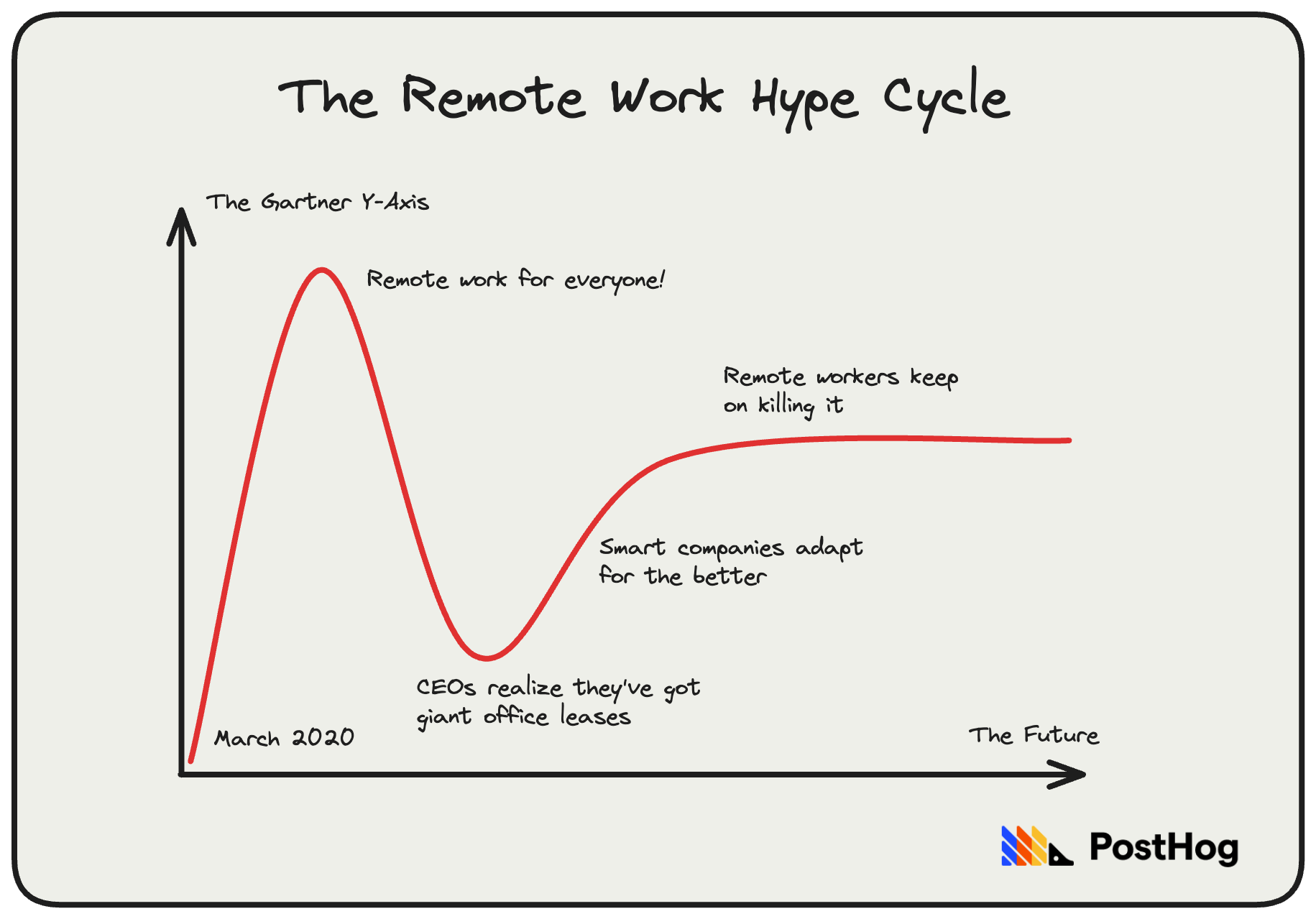The habits of effective remote teams
May 16, 2024

Remote work sucks. If you work at Dell, that is.
In March, it announced remote employees would not be considered for promotions, or be able to change roles. Dell’s rationale, some waffle about “in-person connections” and “value differentiation,” is as tired as a Dell Inspiron trying to run Cyberpunk 2077.
It doesn’t have to be this way. The best remote teams are brimming with energy, are super productive, and do incredible work. So whether you’re part of a remote team, leading one, or want to go remote, here’s how the best of the best make it work, with some tips on how you can up your game, too.
This post was first published in our newsletter, Product for Engineers. It's all about helping engineers and founders build better products by learning product skills. Subscribe here.
1. They write everything down
Remote work doesn't work without a strong writing culture.
Documenting by default – be it information on how to file expenses, your ICP, or what a specific team is working on this quarter – gives everyone access to the same information, regardless of seniority or location.
Why does this work? Because:
It’s faster. Scheduling is hard and meetings interrupt deep work. If something can be written down, it will save time and improve transparency around decision-making. Plus, it's more efficient to have a meeting to align everyone after you've all written down what you think.
It’s always there. If a decision is made on a call and nobody writes it down, was a decision even made? Calls are information black holes so, when you do have a meeting about something, make sure someone, or something, is taking notes. Better yet, don't have a meeting.
It’s clearer. Seriously, have you ever read a transcript of you speaking? Writing is thinking, so it helps you think through both what you’re trying to achieve and how you want to communicate it, making everyone more intentional.
How does this work in practice?
At PostHog, it started with our company handbook – it’s one of the most important things we’ve ever made. It helps everyone understand what we're trying to build and why. Handbooks don't have to be public, but we were inspired by GitLab's 2,000-page handbook, which covers every aspect of how its 2,000+ team members work across 65+ countries.
At Automattic, Beau Lebens has shared some great tips on how to communicate effectively as a remote team and explains traps to avoid. One key takeaway: tools are not the answer. Installing a bunch of bots to transcribe meetings and run automated functions in Slack will only help if you do all the hard work first.
At Doist, and just about any successful remote company, internal email is pretty much banned. As Doist founder and CEO Amir Salihefendic explains, email locks information away. This makes referring back to decisions or conversations either confusing or impossible. Default to communicating out in the open – GitHub, Slack, an internal wiki – so anyone can find and reference conversations and decisions at a later date.

2. They prioritize deep work
In an office setting, the maker’s schedule and the manager’s schedule (sort of) work side by side. But the manager's schedule is the enemy of remote work. Successful remote teams avoid it entirely, which makes them incredibly good at getting shit done.
At PostHog, we’re anti-meeting by default. We have two meeting-free days a week and, when we do have meetings, they’re short, focused, and we take and share written notes where possible. We also only invite people who absolutely need to be there. We optimize for productivity, not presence.
At Doist, four days of each week are dedicated to deep work, with Fridays reserved for housekeeping – bug fixes, battling technical debt, reading, research, and other smaller tasks. It’s an extreme version of time blocking – essentially blocking out four days a week for shipping, with one day reserved for everything else.
When you absolutely have to have meetings, make the most of them. GitLab has a set of principles for how notes should be taken in just about any meeting. This starts with the agenda, which is shared in advance. During meetings, everyone is encouraged to help out with note-taking with a focus on capturing key points rather than every single word that’s said.

Subscribe to our newsletter
Product for Engineers
Helping engineers and founders flex their product muscles
We'll share your email with Substack
3. They value transparency and trust
The biggest (and stupidest) argument against remote work? It makes people less productive. This is demonstrably untrue. We’re an all-remote company, and we ship incredibly fast. Don’t believe us? Believe the Federal Reserve Bank of San Francisco, whose research shows there’s no meaningful productivity loss from remote work.
So, if productivity isn't the problem, what is it? It’s trust. If you trust people to do their very best work, and create a culture that values transparency, they'll deliver. That’s especially true for engineers and developers – Stack Overflow has a great guide that navigates the confusing mess of statistics around productivity and remote work.
How do you build a culture of trust? Here’s a checklist.
Give people autonomy. At PostHog, we hire people who work well with high-level direction, and who are comfortable stepping on toes to get things done. We trust people to do their best work and, in return, they deliver.
Honest feedback. GitLab has a policy of “blameless problem-solving.” Simply put, when something goes wrong, the investigation of the root cause is, as the company puts it, blameless. This encourages everyone to speak up without fear of punishment. People are trusted to make mistakes and, as a result, problems that do arise are easier to solve.
Work in public. At Zapier, trust and transparency are a big part of the company’s values. As co-founder and CEO Wade Foster explains: “Transparency promotes equity and inclusion within our team and customer base. So work in public. Have discussions in the open and document your work.” Successful remote companies build everything out in the open. This gives everyone the context they need, and eliminates the political squabbles that plague less transparent companies.
Shared values. The most successful remote teams have a shared set of values and behaviors – and these are often clearly defined in a public handbook. These values and behaviors are more important than dictatorial processes. As Buffer co-founder and CEO Joel Gascoigne wrote almost a decade ago, “transparency breeds trust, and trust is is the foundation of great teamwork.” It’s still true today.
4. They make meeting up easy
Pretty much all successful remote teams have one thing in common: they’re not remote all the time.
That doesn’t mean hybrid working, or mandatory office days, it means both encouraging meeting up and making it easy to do so.
At PostHog, we achieve this in a bunch of different ways:
$300 monthly co-working budget.** This makes it easy for people to meet up and work together if they already live in the same city.
$1,500 quarterly meet-up budget for ad hoc in-person collaboration with colleagues. This can cover flights, accommodation, and other expenses. At PostHog, Paul and Ben used this recently to meet for a week in Italy and ship our new heatmap and scroll depth feature.
In-person onboarding. When new people join the company, we prioritize organizing an in-person onboarding session as soon as possible. This helps people get to know each other and share important context.
Annual company offsites. The typical agenda includes a couple of big social events, team dinners, a hackathon, all-hands strategy sessions, company culture exercises, and downtime to socialize and explore.
Frequent small team offsites. In addition to our all-company offsite, all our small teams run at least one annual offsite to focus on specific team goals and intense, in-person collaboration. They often include a hackathon, too, but this varies.
Our goal with all of this is to make our in-person time as intentional as possible. To work on big, specific problems, build bonds that create trust, and make asynchronous work more creative and collaborative.
Good reads 📖
Building an all-remote company from scratch – James Hawkins: This is exactly how we built a fully-remote company from the ground up. This was written in 2020 when we were 12 people. Today, we’re almost 50 and it’s still working.
The manager’s schedule is holding remote work back – Luke Thomas: Many makers (hello, product engineers!) have been working remotely successfully for years, but managers can often struggle. Luke shares how to fix that problem.
Why remote work is so hard – and how it can be fixed – Cal Newport: This is a great, detailed read on the long-standing problems that have scuppered remote work. It’s written by Cal Newport, who also coined the term “deep work.”

Subscribe to our newsletter
Product for Engineers
Helping engineers and founders flex their product muscles
We'll share your email with Substack
